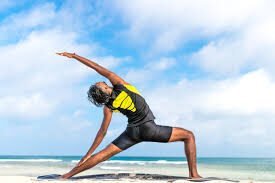Meaning of physical fitness means, It is the capacity of an individual to do work effectively with joy and pleasure. After the work over, he still has sufficient capacity to do more work without any exertion. Moreover, his recovery is faster and quicker. It is the meaning of physical fitness. According to Webster encyclopedia Meaning of physical fitness: “ It is the ability of a person to do daily routine work without fatigue, moreover, to participate in the playful activity and still reserve enough capacity to meet any emergency”.
IMPORTANCE OF PHYSICAL FITNESS
If you are committed, exercise in combination with a sensible diet can help to provide an overall sense of well-being and can even help to prevent chronic illness, disability, and premature death. Some of the benefits of increased physical activity or physical fitness are.
IMPROVED HEALTH:-
Increased efficiency of heart and lungs
Reduced cholesterol level
Increased muscle strength
Reduced blood pressure
Reduced risk of major illnesses such as diabetes and heart disease.
IMPROVED SENSE OF WELLBEING
More energy
Less Stress
Improved quality of sleep
Improve ability to cope with stress
Improve mental sharpness
IMPROVED APPEARANCE
Weight loss
Toned muscles
Improved posture
ENHANCED SOCIAL LIFE
Improve self – image
more opportunity to make new friends
opportunities to share an activity with friends and family members.
INCREASING STAMINA
Enhancement of productivity
physical capabilities
Less frequent injuries
Improved immunity to mirror illness.
COMPONENTS OF PHYSICAL FITNESS
Exercise scientists have identified nine elements/ components that comprise the definition of fitness. The following list of each of the nine elements and an example of how they are used:
STRENGTH:– The extent to which muscles can exert force by contracting against resistance (holding or restraining an object or person).
POWER:- The ability to exert maximum muscular contraction instantly in an explosive burst of movements (jumping or sprint starting).
SPEED:- The quickness of movement of a limb, whether this is a leg of a runner or the arm of the shot putter.
AGILITY:- The ability to perform a series of explosive power movements in rapid succession in opposing directions. (Zigzag running and cutting movements).
BALANCE:-The ability to control the body’s position is either stationary or moving. (eg. A handstand) or while moving (eg. A gymnastic stunt).


FLEXIBILITY:- The ability to achieve an extended range of motion without being impeded by access tissue i.e, fat or muscle (executing a leg split)
LOCAL MUSCLE ENDURANCE:- A single muscle’s ability to perform sustained work ( Rowing Or Cycling)
CARDIOVASCULAR ENDURANCE:- The heart’s ability to deliver blood to working muscles and their ability to use it (Running Long Distance).
STRENGTH ENDURANCE:-A muscle’s ability to perform a maximum contractive time after time (continuous explosive rebounding through an entire basketball game).
CO-ORDINATION:- The ability to integrate the above-listed components so that effective movements are achieved. Physical Fitness is the most easily understood by examining these components, or elements, or parts.
ENDURANCE
The ability to deliver oxygen and nutrients to tissue, and to remove waste, over a sustained period of time. Long runs and swims are among the methods employed in measuring this component.
- Short term/ anaerobic/ muscular endurance:- the component of endurance is helpful to perform an activity is done for a longer duration with fast speed.
- Long-term/ aerobic/ cardiovascular endurance:- The endurance is helpful when the activity is done for a longer duration and the intensity or speed is slower.
STRENGTH
It is the ability of muscles to overcome resistance. Strength can be defined as the amount of force a muscle can exert. It is an amount of force a muscle can exert. It is an essential component of games and sports.
- STATIC STRENGTH: It is also known as isometric strength. It is the ability to act against resistance from a single or one position. Eg. Arm wrestling, Power Lifting, Pushing Wall, Etc.
- DYNAMIC STRENGTH: It is also known as Isotonic strength. It is related to movement. Thus, we can say that it is required for movement. It is of three types.
- MAXIMAL STRENGTH: It is the ability to act against maximum resistance. It is the quality of muscles to contract forcefully in the quickest possible time. Eg. Weight-lifting, throwing, etc.
- EXPLOSIVE STRENGTH: It is the ability to overcome resistance at high speed. in fact, it is a combination of strength and speed.
- STRENGTH ENDURANCE: It is a combination of strength and endurance ability. It is defined as the ability to overcome resistance under fatigue conditions. Eg. Chin-ups
SPEED
It is the ability to perform the movement at a faster rate. In other words, it is the ability to move as fast as possible. Speed is basically dependent on heredity but can be improved through proper training. It is of three types:-
- REACTION TIME:- It is time taken by the body to respond immediately after the stimulus.
- ACCELERATION:- It is the time taken by the body to reach maximum speed.
- SPEED OF MOVEMENT:- It is the quickness of complete action or movement.
FLEXIBILITY
It is the ability of joints to move in maximum range. In other words, this is the range of a joint to move maximum It is measured through flexometer.
- PASSIVE FLEXIBILITY:- It is the ability of a joint to move in maximum range with external help. Eg. Stretching with a partner
- ACTIVE FLEXIBILITY:– It is performed without external help or self-movement of a part to maximum range. It is of two types.
- STATIC FLEXIBILITY:– It is the ability flexibility performed from a stationary position eg. Chakra asana, toe touching, sideward bending, etc.
- DYNAMIC FLEXIBILITY:– It is flexibility performed while in motion or movement. This is required in gymnastics, diving, etc.
CO-ORDNATIVE ABILTY OR AGILITY
It is the ability of the body to perform the movement with perfection and efficiency. or we can say the ability of the human body to change direction quickly and effectively. It is mainly neuro-muscular coordination that depends upon the central nervous system.
meaning of physical fitness
PRINCIPLE OF PHYSICAL FITNESS
THE FIVE BASIC PRINCIPLE OF FITNESS ARE:-
1. The Overload Principle
2. The FITT principle
3. The Specificity Principle
4. The Rest And Recovery Principle
5. The Use Or Lose Principle
THE OVERLOAD PRINCIPLE
The overload principle is probably the most important principle of exercise and training. Simply stated the overload principle means that the body will adapt to the workload placed upon it. The more you do, the more you will be capable of doing. This is how all the fitness improvements occur when exercising and training. The concept is similar in cardiovascular training if you ask the heart, lungs and endurance muscles to do work not previously done, it will make changes to the body to be able to handle that task better the next time. This is how people get stronger, bigger, and increase the workload of a given workout you need to understanding the F.I.T.T. principle.
THE F.I.I.T PRINCIPLE
An easy way to get started on developing a personal fitness program is utilizing the F.I.T.T. principle. The acronym stands for frequency, intensity, time, and type.
These are the areas in which someone could increase or overload in order to improve physical fitness.
- FREQUENCY: This refers to how often you will exercise after any form of exercise is performed your body completes the process of rebuilding and repairing so, determining the frequency of exercise is important in order to find a balance that provides just enough stress for the body to adapt and also allows enough rest time for healing.
- INTENSITY: defined as the amount of effort or work that must be completed in a specific exercise this too requires a good balance to ensure that the intensity is hard enough to overload the body but not so difficult that it results in overtraining, injury or burnout.
- TIME: Time is simply how long each individual session should last. This will vary based on the intensity and type.
- TYPE: What type of exercise will you be doing? Will an exercise session be primarily cardiovascular resistance training or a combination of both? And what specific exercises will you perform?
THE SPECIFICITY PRINCIPLE
This principle is just how it sounds. how you exercise should be specific to your goals. If you are trying to improve your racing times, you should focus on speed workouts. If your main goal is simply health, fitness, and weight management, you should focus on total body strength, cardio, and a healthy diet. Make sure your training matches your goal.
THE REST AND RECOVERY PRINCIPLE
While we often focus on getting in as much exercise as possible, rest and recovery are also essential for reaching your weight loss and fitness goals. While you can do cardio every day ( though you may want to rest after every intense workout) you should have at least a day of rest between strength training workouts. Make sure you don’t work on the same muscles two days in a row to give your body the time it needs to rest and recover.
meaning of physical fitness
THE USE OR LOSE PRINCIPLE
The principle of use or loss implies that when it comes to fitness, you “use it or lose it”. This simply means that your muscles build strength( hypertrophy) with use and lose strength (atrophy) with a lack of use. This also explains why we lose fitness when we stop exercising.
CAREER OPPORTUNITY IN THE FIELD OF PHYSICAL FITNESS
- PHYSICAL EDUCATION TEACHER: Physical education teachers typically work in school and teach physical fitness to children. They are responsible for teaching children about health, sports, and personal fitness. Physical education teachers at public schools must be certified by their state, the minimum requirement of most of the states is a bachelor’s degree in physical education.
- PERSONAL TRAINER: Personal trainer helps individuals or small groups improve their physical fitness by guiding them through aerobic and strength-building workouts. The trainer might work in gyms or in clients’ homes. Personal trainers are expected to have a strong understanding of physical fitness techniques. They might have a bachelor’s degree in exercise science or have a diploma in fitness.
meaning of physical fitness
https://www.sportzyogi.com/foundation-of-physical-education/




